Abstract
The interaction of mono- and polyclonal neutralizing antibodies with poliovirus was studied. In all cases, neutralization was due to antibody-mediated virus aggregation, and the unpolymerized virions accounted for the residual infectivity. The effect of papain on previously neutralized virus was to deaggregate the virus to fully infective single virions. With some antibodies, the amount of aggregated virus regressed in the region of greatest antibody excess, even though the virus remained fully neutralized. Under these conditions, noninfective, unaggregated immune complexes were formed. A mutant resistant to one of the monoclonal antibodies was selected. The mutant virions were still bound but no longer aggregated or neutralized by the selecting antibodies.
Full text
PDF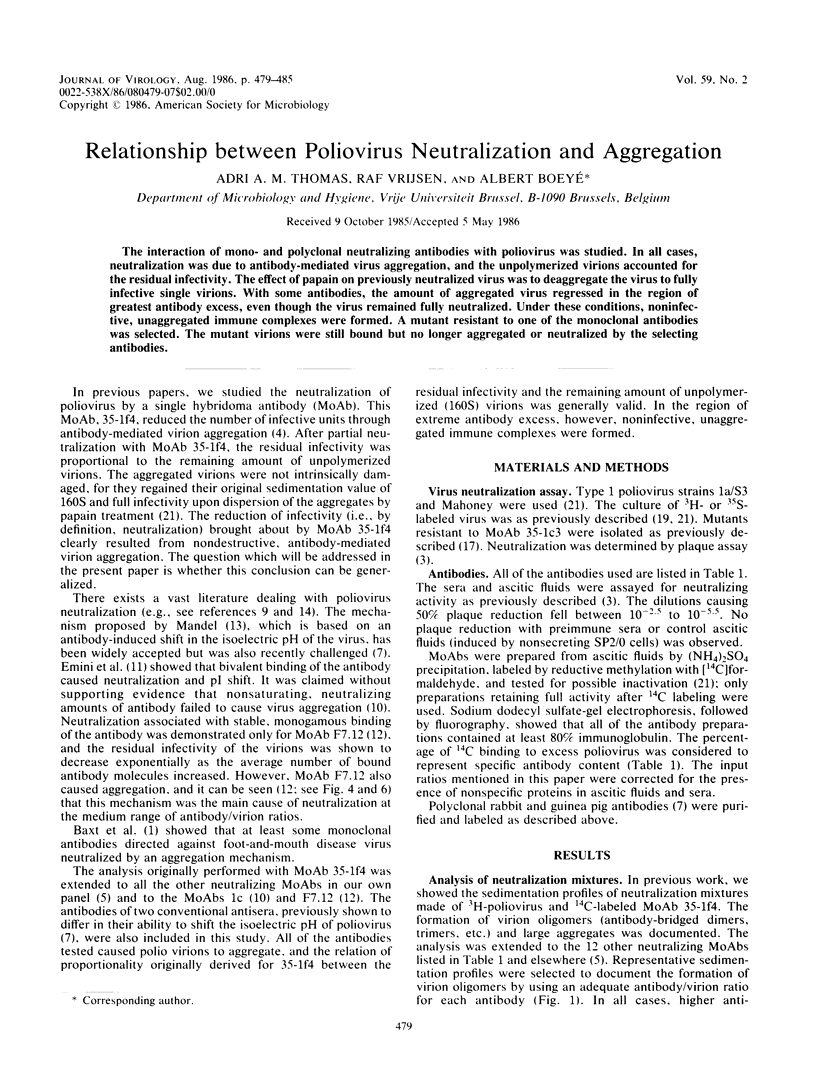
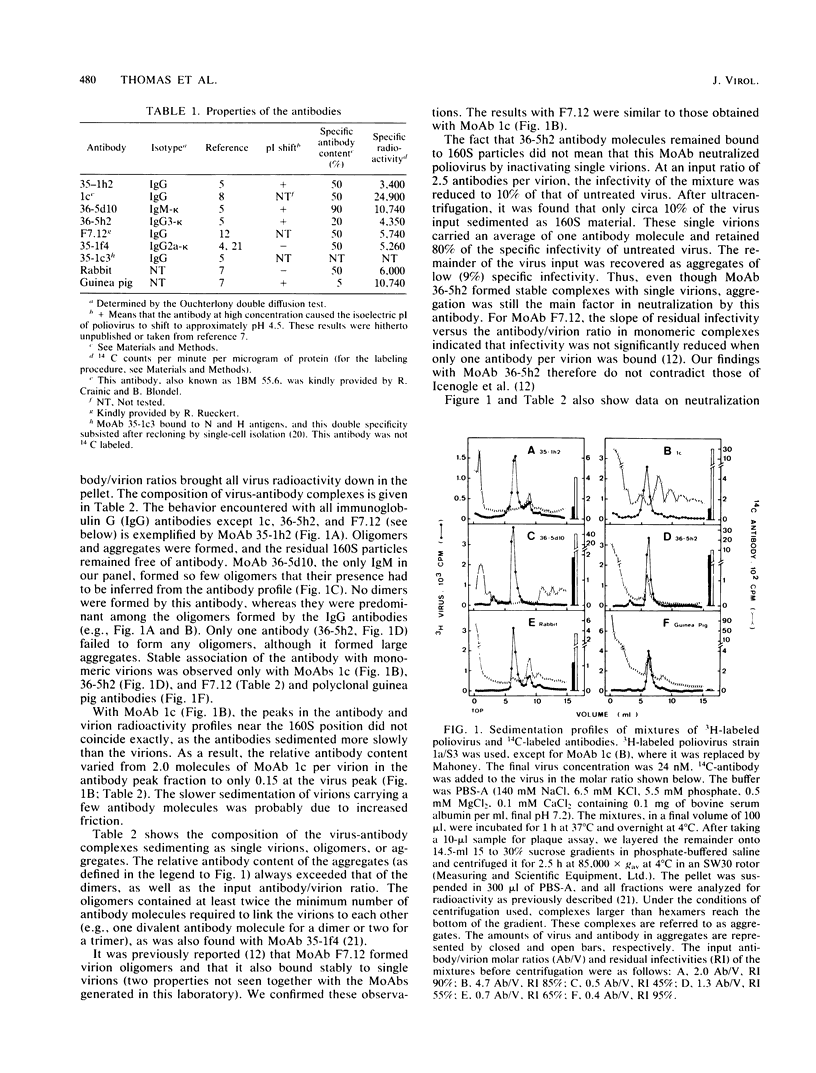
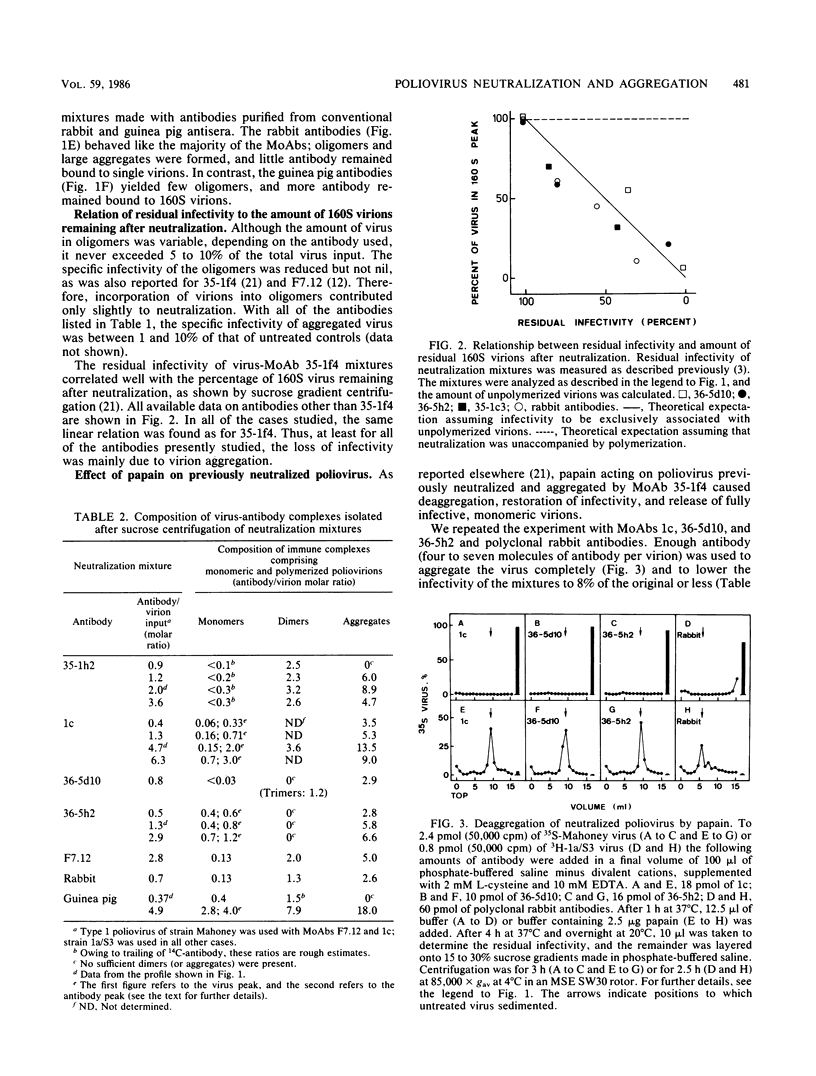
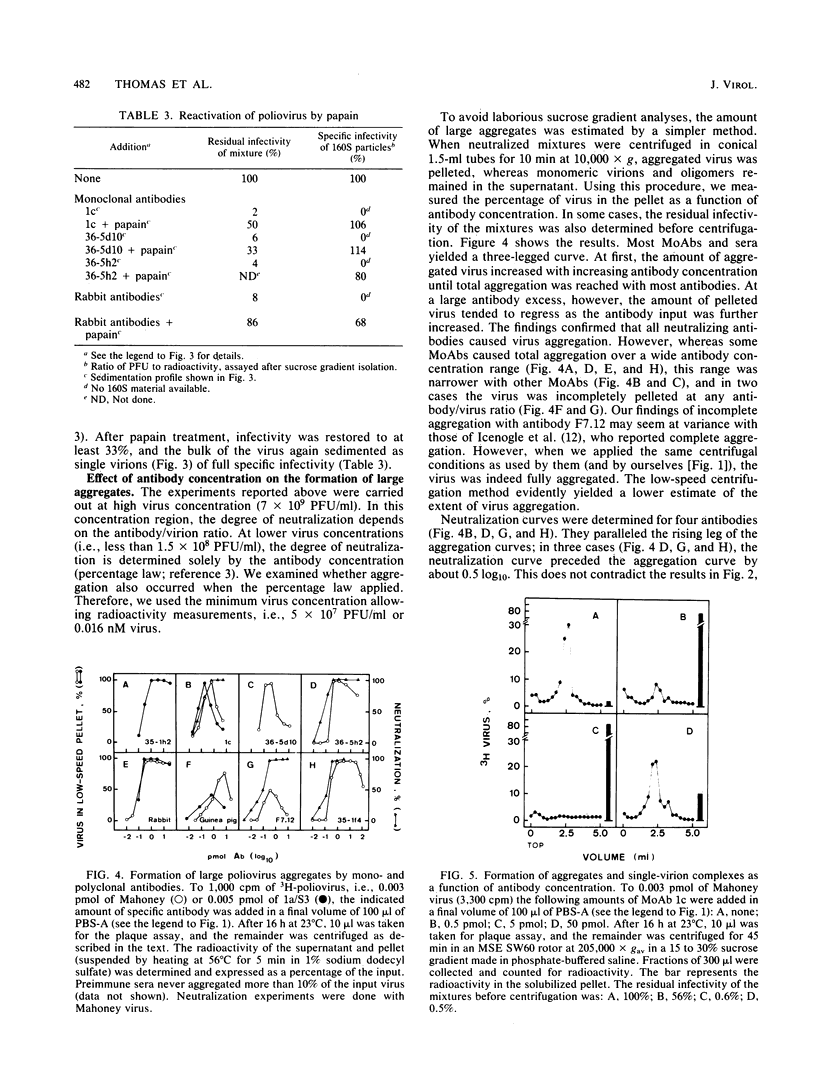
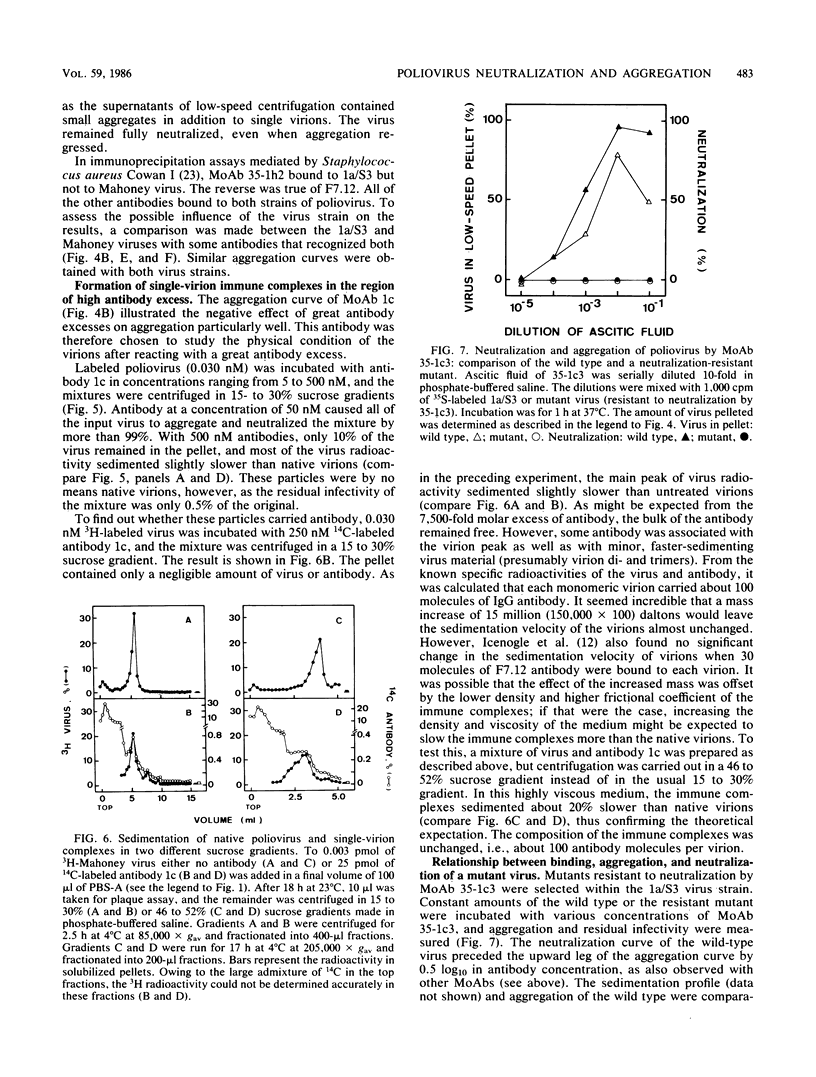
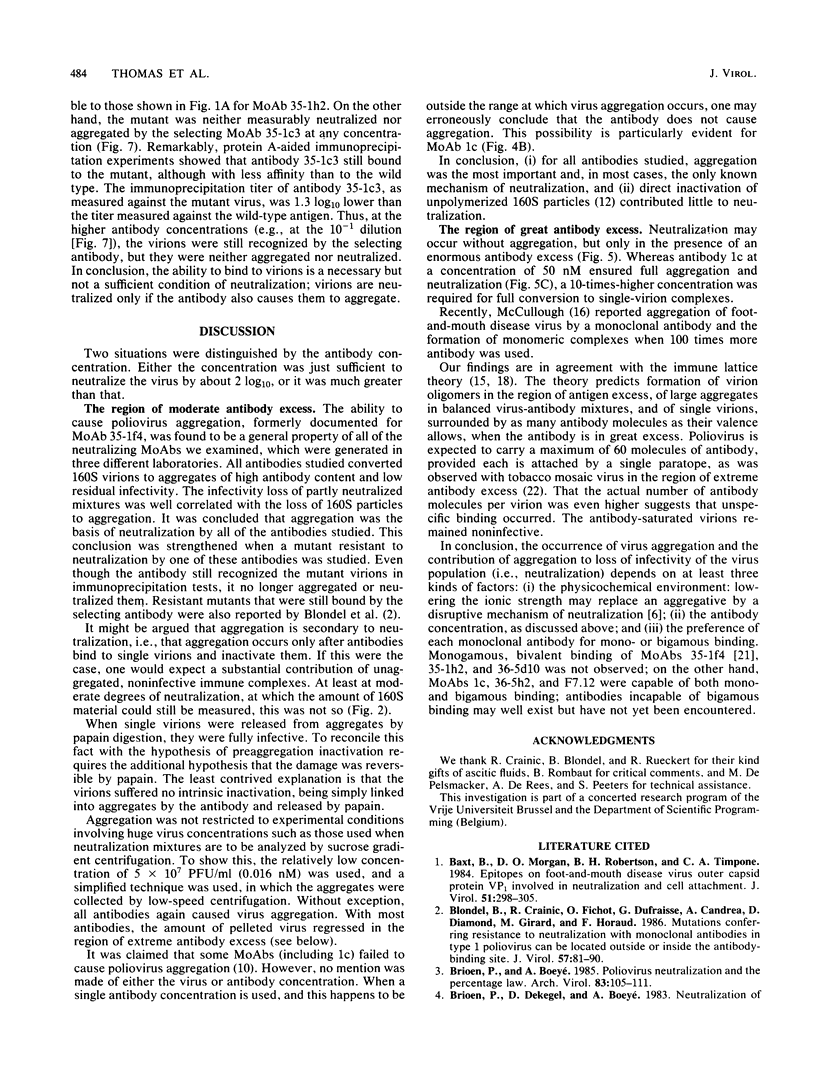
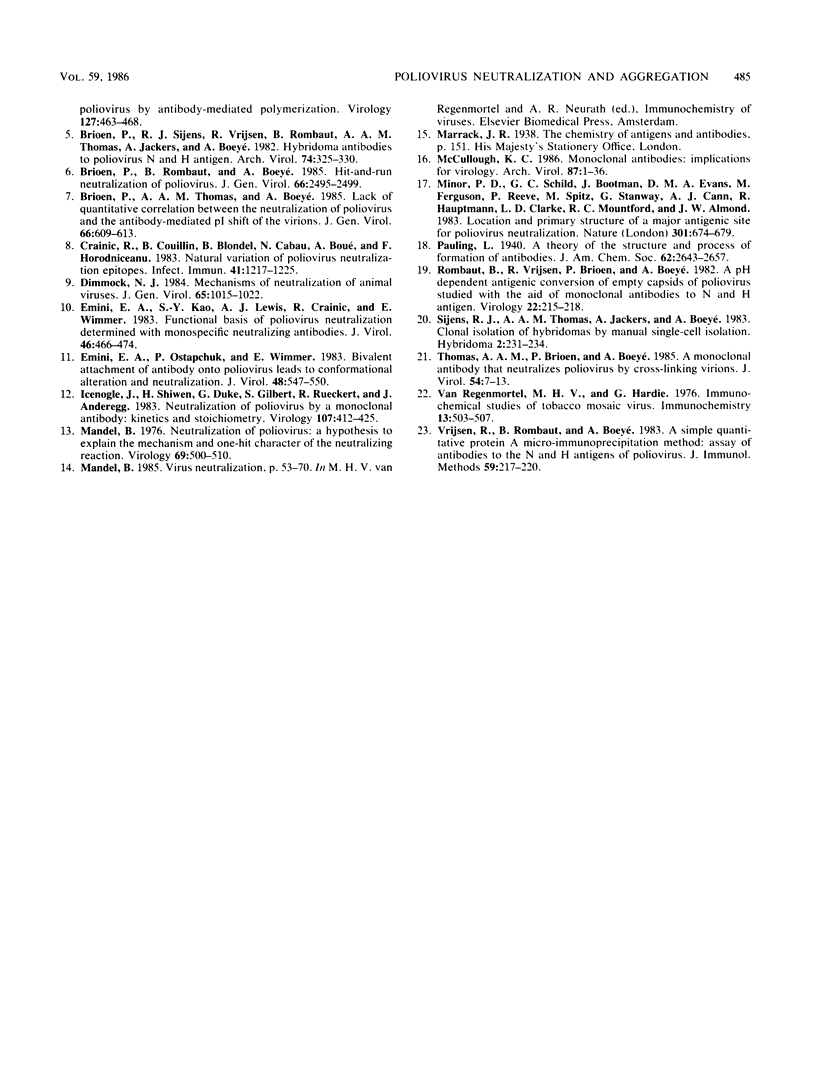
Selected References
These references are in PubMed. This may not be the complete list of references from this article.
- Baxt B., Morgan D. O., Robertson B. H., Timpone C. A. Epitopes on foot-and-mouth disease virus outer capsid protein VP1 involved in neutralization and cell attachment. J Virol. 1984 Aug;51(2):298–305. doi: 10.1128/jvi.51.2.298-305.1984. [DOI] [PMC free article] [PubMed] [Google Scholar]
- Blondel B., Crainic R., Fichot O., Dufraisse G., Candrea A., Diamond D., Girard M., Horaud F. Mutations conferring resistance to neutralization with monoclonal antibodies in type 1 poliovirus can be located outside or inside the antibody-binding site. J Virol. 1986 Jan;57(1):81–90. doi: 10.1128/jvi.57.1.81-90.1986. [DOI] [PMC free article] [PubMed] [Google Scholar]
- Brioen P., Boeyé A. Poliovirus neutralization and the percentage law. Brief report. Arch Virol. 1985;83(1-2):105–111. doi: 10.1007/BF01310968. [DOI] [PubMed] [Google Scholar]
- Brioen P., Dekegel D., Boeyé A. Neutralization of poliovirus by antibody-mediated polymerization. Virology. 1983 Jun;127(2):463–468. doi: 10.1016/0042-6822(83)90159-9. [DOI] [PubMed] [Google Scholar]
- Brioen P., Rombaut B., Boeyé A. Hit-and-run neutralization of poliovirus. J Gen Virol. 1985 Nov;66(Pt 11):2495–2499. doi: 10.1099/0022-1317-66-11-2495. [DOI] [PubMed] [Google Scholar]
- Brioen P., Sijens R. J., Vrijsen R., Rombaut B., Thomas A. A., Jackers A., Boeyé A. Hybridoma antibodies to poliovirus N and H antigen. Arch Virol. 1982;74(4):325–330. doi: 10.1007/BF01314165. [DOI] [PubMed] [Google Scholar]
- Brioen P., Thomas A. A., Boeyé A. Lack of quantitative correlation between the neutralization of poliovirus and the antibody-mediated pI shift of the virions. J Gen Virol. 1985 Mar;66(Pt 3):609–613. doi: 10.1099/0022-1317-66-3-609. [DOI] [PubMed] [Google Scholar]
- Crainic R., Couillin P., Blondel B., Cabau N., Boué A., Horodniceanu F. Natural variation of poliovirus neutralization epitopes. Infect Immun. 1983 Sep;41(3):1217–1225. doi: 10.1128/iai.41.3.1217-1225.1983. [DOI] [PMC free article] [PubMed] [Google Scholar]
- Dimmock N. J. Mechanisms of neutralization of animal viruses. J Gen Virol. 1984 Jun;65(Pt 6):1015–1022. doi: 10.1099/0022-1317-65-6-1015. [DOI] [PubMed] [Google Scholar]
- Emini E. A., Kao S. Y., Lewis A. J., Crainic R., Wimmer E. Functional basis of poliovirus neutralization determined with monospecific neutralizing antibodies. J Virol. 1983 May;46(2):466–474. doi: 10.1128/jvi.46.2.466-474.1983. [DOI] [PMC free article] [PubMed] [Google Scholar]
- Emini E. A., Ostapchuk P., Wimmer E. Bivalent attachment of antibody onto poliovirus leads to conformational alteration and neutralization. J Virol. 1983 Nov;48(2):547–550. doi: 10.1128/jvi.48.2.547-550.1983. [DOI] [PMC free article] [PubMed] [Google Scholar]
- Icenogle J., Shiwen H., Duke G., Gilbert S., Rueckert R., Anderegg J. Neutralization of poliovirus by a monoclonal antibody: kinetics and stoichiometry. Virology. 1983 Jun;127(2):412–425. doi: 10.1016/0042-6822(83)90154-x. [DOI] [PubMed] [Google Scholar]
- Mandel B. Neutralization of poliovirus: a hypothesis to explain the mechanism and the one-hit character of the neutralization reaction. Virology. 1976 Feb;69(2):500–510. doi: 10.1016/0042-6822(76)90480-3. [DOI] [PubMed] [Google Scholar]
- McCullough K. C. Monoclonal antibodies: implications for virology. Brief review. Arch Virol. 1986;87(1-2):1–36. doi: 10.1007/BF01310540. [DOI] [PubMed] [Google Scholar]
- Minor P. D., Schild G. C., Bootman J., Evans D. M., Ferguson M., Reeve P., Spitz M., Stanway G., Cann A. J., Hauptmann R. Location and primary structure of a major antigenic site for poliovirus neutralization. Nature. 1983 Feb 24;301(5902):674–679. doi: 10.1038/301674a0. [DOI] [PubMed] [Google Scholar]
- Rombaut B., Vrijsen R., Brioen P., Boeyé A. A pH-dependent antigenic conversion of empty capsids of poliovirus studied with the aid of monoclonal antibodies to N and H antigen. Virology. 1982 Oct 15;122(1):215–218. doi: 10.1016/0042-6822(82)90393-2. [DOI] [PubMed] [Google Scholar]
- Sijens R. J., Thomas A. A., Jackers A., Boeyé A. Clonal isolation of hybridomas by manual single-cell isolation. Hybridoma. 1983;2(2):231–234. doi: 10.1089/hyb.1983.2.231. [DOI] [PubMed] [Google Scholar]
- Thomas A. A., Brioen P., Boeyé A. A monoclonal antibody that neutralizes poliovirus by cross-linking virions. J Virol. 1985 Apr;54(1):7–13. doi: 10.1128/jvi.54.1.7-13.1985. [DOI] [PMC free article] [PubMed] [Google Scholar]
- Van Regenmortel M. H., Hardie G. Immunochemical studies of tobacco mosaic virus--II. Univalent and monogamous bivalent binding of IgG antibody. Immunochemistry. 1976 Jun;13(6):503–507. doi: 10.1016/0019-2791(76)90326-8. [DOI] [PubMed] [Google Scholar]
- Vrijsen R., Rombaut B., Boeyé A. A simple quantitative protein A micro-immunoprecipitation method; assay of antibodies to the N and H antigens of poliovirus. J Immunol Methods. 1983 Apr 29;59(2):217–220. doi: 10.1016/0022-1759(83)90033-9. [DOI] [PubMed] [Google Scholar]


